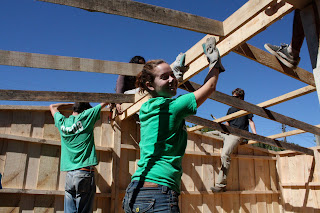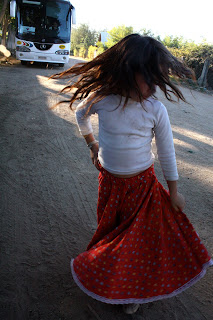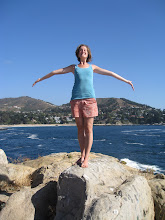It’s been just over three weeks now since the magnitude 8.8 earthquake hit Chile. In some ways, here in Santiago it feels as though nothing happened. City life appears to be functioning normally: bars and restaurants are open and full of customers, joggers trudge along running paths and couples spend afternoons canoodling in the shady pockets of grassy parks. I spent my day yesterday reading next to a fountain and now sit in a café sipping coffee while I write this.
At VE, we’ve mostly returned to our normal daily routines, as well. Our volunteers head to their institutions every day to help the children with homework, organize sports and arts activities, etc. Outside of work we cook meals together, play games, and gossip, carrying on as we did before the earthquake.
Despite this normalcy, there’s an underlying sense of tension and exhaustion here. Perhaps it’s only in my head and I’m projecting it onto the entire city, but I get the sense that everyone feels a bit emotionally rattled (bad earthquake humor not intended). Among my friends here, I’ve seen a huge variety of reactions, ranging from no reaction whatsoever to mild emotional turmoil. Navigating the rollercoaster of emotions has been a huge challenge. Although my VE role as Director of Volunteer Relations suggests that I should be tending to the emotional needs of all the volunteers, I’ve been left feeling overwhelmed and under-qualified to handle the variety.
That the range of reactions is so vast should come as no surprise, as the earthquake was undeniably terrifying. It hit at 3:34 on Saturday morning, February 27th, while my roommates, Chris and Annie, and I were all sleeping. I woke to the sound of the wooden painting hanging at the foot of my bed clanking against the wall. Once awake, I realized my entire room was shuddering and swaying, my door repeatedly swinging open and slamming shut. There was the unfamiliar sound of cracking plaster and the rumble of shifting furniture as my nightstand and desk slid away from the wall. The items close to the edges of the desk and nightstand danced their way to the floor and the one, highly embarrassing thought I remember having was that I felt as though I were on the sinking Titanic. I’ll never let go, Jack.
The first earthquake lasted for a staggering 90 seconds. I had fallen asleep with the lamp on my nightstand on, so I was extremely aware that about 35 seconds into the shaking, the power went out. The shaking became so severe near the end that I didn’t feel as though I could get out of my bed and walk in a straight line to my doorway. Not that the logical thought of getting to a doorway even crossed my mind. So I stayed in bed. Our apartment is on the 15th floor and the swaying was so extreme, I was convinced the building was going to topple over. Tall buildings are built to move that way in the case of an earthquake, but that doesn’t mean it’s going to feel like a joy ride while it’s happening.
Not even five seconds after the shaking stopped, Annie came running into my room, saying, “Are you okay? Are you okay?” Chris was right behind her and I sat up, staring at them, saying, “Yeah, yeah,” trying to process what had just happened. We made our way into the living room where our floor-to-ceiling windows showed us that the entire city was out of power. We live just across the Mapocho River from Barrio Bellavista, one of the main “going out” neighborhoods with blocks upon blocks of bars and nightclubs, so we got to witness the mass exodus of the Friday night partiers making their way out of the darkened clubs. 3:30 is prime party-time in Santiago, so the streets were quickly filled with inebriated people who suddenly needed a ride home. Buses drove past the overflowing bus stops, causing a few desperate individuals to run into the street to try to make them stop.
After about an hour of watching the scene on the street and surveying the relatively minor damage in our apartment, we decided that going back to sleep was the next logical step. As I drifted off, however, I received a call from my friend Matt who informed me that we should leave the building for a couple of hours in case of a big aftershock. We took the first of many trips down the fifteen flights of stairs and found about twenty other people from our building sitting outside. While we waited, we sent text messages to everyone we could think of and confirmed that, although everyone was freaked out, we were all safe and sound.
At about 5:45, we decided to leave the grannies and their doggies and headed back up to the apartment to try to get some sleep. At 7:30 I was awoken by the first big aftershock and decided to give up on sleeping. At 8:00, our friend Meghan came over, as she had been alone in her apartment and had received a phone call from her mom who saw the first news reports in the US with pictures from Concepción, a city to the south of Santiago that was practically destroyed by the earthquake. She told Meghan about the tsunami warnings and, having no sense for the situation in Santiago, was an understandable wreck.
By the afternoon on Sunday we had electricity and cold water back, so much of the remainder of the day was spent reassuring family and friends that we were safe. Although I was extremely relieved that we were safe and had electricity and water, the city was quiet in an unsettling way. The Metro wasn’t running and we found only two convenience stores open for buying snacks and water. We heard from a Chilean friend that sometimes the water can be unsafe to drink after a big earthquake because of excess minerals. Knowing that, then being unsure of how long the water supply would last at the two open stores, was an interesting, albeit tiny, taste of the panic one must feel when he or she don’t have access to basic resources. We concluded the day on a positive note, however, as a group of us spent the evening in the VE office playing Catchphrase and Pictionary, happy to be together and laughing.
Each day after the earthquake brought us both a little closer and a little further from normalcy. Restaurants and select grocery stores re-opened, but the shelves were increasingly barren each day, raising concerns about when they’d be able to re-stock. We had gas back in our apartment by Sunday afternoon, but had friends who were still without gas over a week later. Chilean schools, meant to open the first week of March, were all delayed at least a week.
Then, of course, the aftershocks. When a huge earthquake hits, it’s normal for aftershocks to occur for weeks or even months after the main quake. We began following the earthquakes on the US Geological Survey website and by six days after the earthquake, there had been over 200 aftershocks. Just when a day would feel normal, a big aftershock would hit and we’d all be reminded that we were in the middle of something quite nutty.
On the VE side of things, our tiny March class became a blessing in disguise as we were forced to postpone, and ultimately cancel, the orientation week that was meant to begin March 1st, the Monday after the earthquake. One of the two new volunteers had arrived a few days before the earthquake and the other spent hours on the phone with his airline, finally able to secure a flight that arrived on Friday the 5th. We decided, after spending hours organizing and re-organizing the orientation schedule, that we would just give both of the volunteers a mini, personalized orientation.
In the midst of the craziness, we still managed to have VE Palooza, the celebration to close each three-month cycle of VE, although it was a cozy, modified version at my apartment on the Sunday after the earthquake. We also held a modified version of Café, the celebration with skits, etc, at the end of each Orientation week. In the interest of sending positive vibes to Chile, Matt and I donned our cueca garb and introduced the new volunteers to the national dance. In the interest of keeping it real, the VE women reprised their performance of Soulja Boy from Festival de Arte.
As the first couple of weeks after the earthquake passed, we found that another huge challenge was figuring out how we can help in the earthquake relief effort. Just a couple hours south of Santiago the situations are extremely dire, but finding an effective way to contribute in a meaningful way proved quite difficult. The few well-organized options were flooded with people wanting to help and we didn’t want to just hop onto something to feel good about ourselves. We ended up helping out in the Red Cross Chile warehouse here in Santiago, making care kits and helping load and unload trucks of donations. Although they seemed to have a lot of volunteers, it felt good to contribute at least a tiny bit in a concrete way.
We’re also working to raise money to repair the damage that our partner institutions faced. A couple of the institutions came through almost unscathed, while others suffered severe damages. And here I shamelessly say that if you’d like to donate to VE to help in this rebuilding effort, you can click here.
Now, if you’ve made it this far in this grossly long post, I’m going to end on a sappy note. I always feel lucky to be a part of the VE community, as I’ve gushed about many, many times in this blog. It’s during times like this, though, that I feel even more fortunate to have so many people around to freak out with and laugh with and eat cookie dough with when that seems like the only possible solution. It’s been a crazy few weeks but I’m still content to be where I am.
I’ll leave you with some pictures:
Here’s some of the damage from our apartment, just a bit of missing plaster:

The worse damage is in the hallways of our building:



At the VE office, the turtles (Vanessa and Eddie) had a wild, almost-fatal ride (Thanks to Matt for the photo):

Our friend Meghan’s apartment suffered much worse damage than ours. In her kitchen, every single dish and glass broke. Here’s a shot she took:

Around Santiago, there are a few instances of damage that make me shocked the city didn’t suffer more. Thanks to my friend Lucía for these shots:




At the Aldea María Reina, a home for adolescent girls and one of our partner institutions, the entire front wall collapsed, leaving the barbed wire hanging alone:

Matt and I dancing the cueca at Café:

The VE women doing what they do best:













 The next morning we drove to the salt flat. On our way in, while trying to wrap our heads around what we were looking at, we drove past a man on a bicycle with a baby on the back. The surreality was thick. Here's a photo I snapped of the other Jeep while we were driving quite closely to each other on the salt flat:
The next morning we drove to the salt flat. On our way in, while trying to wrap our heads around what we were looking at, we drove past a man on a bicycle with a baby on the back. The surreality was thick. Here's a photo I snapped of the other Jeep while we were driving quite closely to each other on the salt flat:
 The tour also stopped by the first ever salt hotel, outside of which were these piles of salt:
The tour also stopped by the first ever salt hotel, outside of which were these piles of salt:
 After the tour ended, our group went separate ways. Annie, Ashton, Madinah, and I continued on into Bolivia for a few days. After discovering that juice-in-a-bag was the best thing Uyuni had to offer beyond the salt flat and the train cemetery, we decided to take the next bus to Sucre, a beautiful introduction to Bolivian cities. Sucre has, in my opinion, an excellent balance of beauty and grit. The main square, pictured below, is charming, filled with manicured gardens and surrounded by gorgeous buildings.
After the tour ended, our group went separate ways. Annie, Ashton, Madinah, and I continued on into Bolivia for a few days. After discovering that juice-in-a-bag was the best thing Uyuni had to offer beyond the salt flat and the train cemetery, we decided to take the next bus to Sucre, a beautiful introduction to Bolivian cities. Sucre has, in my opinion, an excellent balance of beauty and grit. The main square, pictured below, is charming, filled with manicured gardens and surrounded by gorgeous buildings. There seemed to be a fair amount of tourism, but there were also plenty of opportunities to see the vast differences between Bolivia and Chile. Living in Santiago, I sometimes forget what South America is really like. With it's big business and Wi-fi everywhere you go, Santiago is very much a modern, developed city. Sucre, although a beautiful city with everything you could need, was a reminder of a different way of life. A large percentage of the Bolivian women we saw, for example, wore traditional dress. Street stalls such as the one pictured below were much more common than grocery stores and seemed to be the way most people purchased all of their goods. It was difficult to find a soda or bottle of water that was refrigerated, but very easy to purchase fresh, unpackaged foods on the street. We were there on Bolivian mother's day and on the night before, it seemed that one in every twenty people was carrying an uncovered cake amidst the crowded streets.
There seemed to be a fair amount of tourism, but there were also plenty of opportunities to see the vast differences between Bolivia and Chile. Living in Santiago, I sometimes forget what South America is really like. With it's big business and Wi-fi everywhere you go, Santiago is very much a modern, developed city. Sucre, although a beautiful city with everything you could need, was a reminder of a different way of life. A large percentage of the Bolivian women we saw, for example, wore traditional dress. Street stalls such as the one pictured below were much more common than grocery stores and seemed to be the way most people purchased all of their goods. It was difficult to find a soda or bottle of water that was refrigerated, but very easy to purchase fresh, unpackaged foods on the street. We were there on Bolivian mother's day and on the night before, it seemed that one in every twenty people was carrying an uncovered cake amidst the crowded streets. On our last full day in Sucre, we took a half-day hike along a portion of the Inca Trail. The four of us had a private tour with a Bolivian guide who, along with being fascinated by his first all-female tour group, told us lots of interesting information about Bolivian culture and history. Bolivia's current president, Evo Morales, has declared himself to be the first indigenous president, for example. He's also apparently known for the striped sweater he always wears, which has become a popular style in Bolivia since he took office.
On our last full day in Sucre, we took a half-day hike along a portion of the Inca Trail. The four of us had a private tour with a Bolivian guide who, along with being fascinated by his first all-female tour group, told us lots of interesting information about Bolivian culture and history. Bolivia's current president, Evo Morales, has declared himself to be the first indigenous president, for example. He's also apparently known for the striped sweater he always wears, which has become a popular style in Bolivia since he took office. 









































